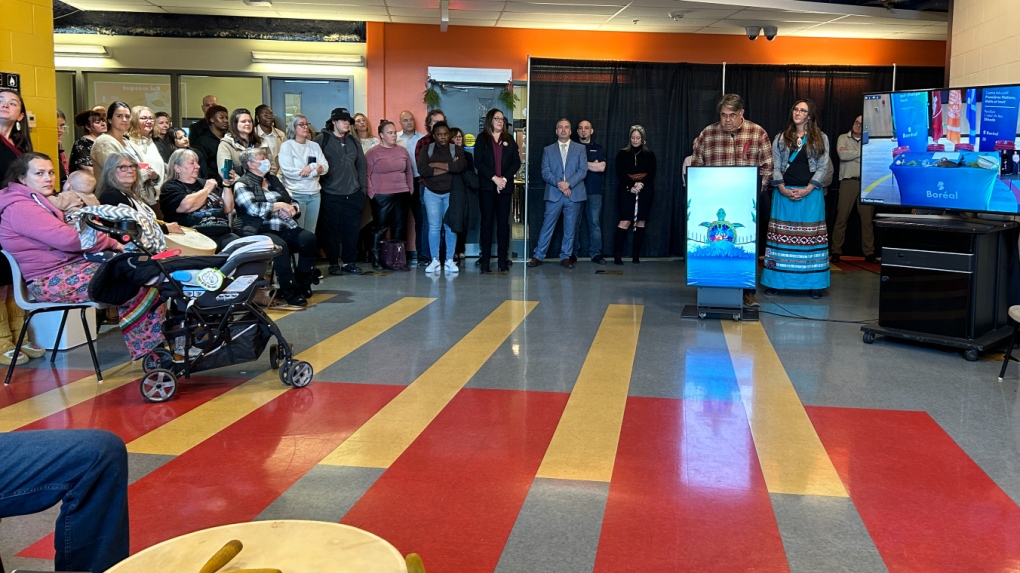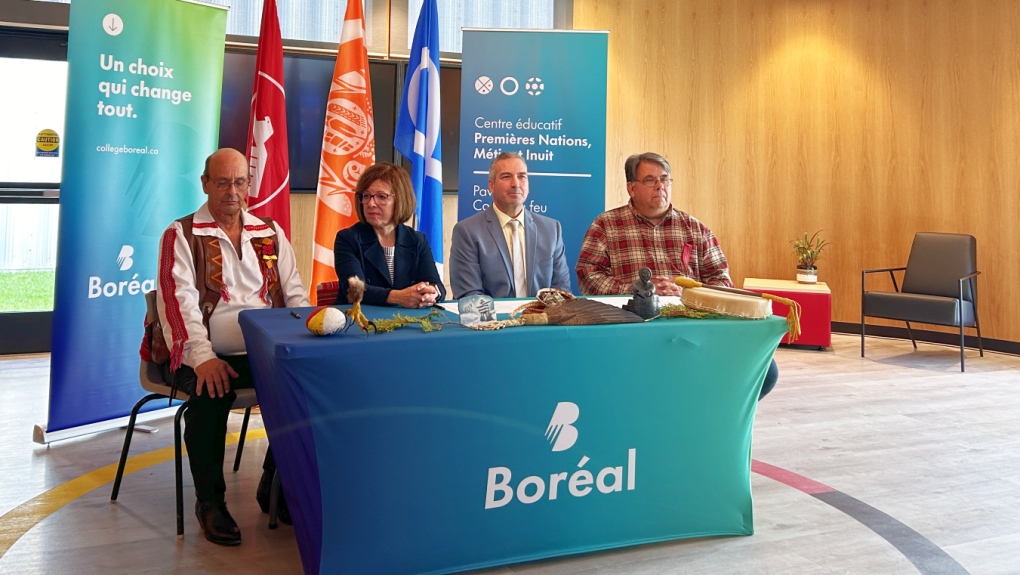Sudbury’s College Boreal opens Indigenous pavilion
College Boreal in Sudbury officially opened its Indigenous pavilion on Tuesday.
Speeches, drumming, dancing and song marked the opening ceremony.
 Called the Shkode Heart of Fire Pavilion, the First Nations, Metis and Inuit educational centre will offer a combination of in-person and online learning. (Amanda Hicks/CTV News)
Called the Shkode Heart of Fire Pavilion, the First Nations, Metis and Inuit educational centre will offer a combination of in-person and online learning. (Amanda Hicks/CTV News)
Called the Shkode Heart of Fire Pavilion, the First Nations, Metis and Inuit educational centre will offer a combination of in-person and online learning.
"We are a learning institution, and we are a community college," said Daniel Giroux, college president.
"So anytime we can give back to the students, to the community, it's extremely important."
Planning for the pavilion began in 2019, with construction starting in January of this year.
"It's a lot of consulting, even from the naming," Giroux said.
"For us, we wanted to get it right. We wanted to build it right, so we weren't pressured. It's important to consult with the elders, with the community. That's probably why it took a little bit longer."
The pavilion was financed by the college with a total investment of more than $1.2 million as part of the institution’s response to the Truth and Reconciliation Commission’s calls to action.
The name, Shkode, is an Obijiway word meaning "flame" or "fire," meant as a welcoming to encourage learning and deeper understanding.
 Called the Shkode Heart of Fire Pavilion, the First Nations, Metis and Inuit educational centre will offer a combination of in-person and online learning. (Amanda Hicks/CTV News)
Called the Shkode Heart of Fire Pavilion, the First Nations, Metis and Inuit educational centre will offer a combination of in-person and online learning. (Amanda Hicks/CTV News)
"The fire that's within our heart, almost like welcoming around a campfire," said Richard Meilleur, elder in residence for Shkode.
"That fire we use for knowledge, acknowledging knowledge, sharing and teaching it with the community, with the students."
The pavilion spans more than 2,000 square feet with two meeting rooms and a circle for smudging ceremonies and traditional events, meant to encourage both online and in-person activities.
Additionally, there is art paying tribute to Indigenous artists, including a collection dedicated to the memory of Metis leader Louis Riel.
- Download the CTV News app now
- Get local breaking news alerts
- Daily newsletter with the top local stories emailed to your inbox
"The most important thing was to gather items that were present represents the people where they come from. So, when they do come to the centre, they have a piece of themselves in that centre," Meilleur said.
"It’s like saying 'I know that symbol. I know I'm welcome here.'"
Workshops became available to students online as of fall of this year. Now, with the pavilion open, more will become available in person.
CTVNews.ca Top Stories

Quebec fugitive killed in Mexican resort town, RCMP say
RCMP are confirming that a fugitive, Mathieu Belanger, wanted by Quebec provincial police has died in Mexico, in what local media are calling a murder.
Trump again calls to buy Greenland after eyeing Canada and the Panama Canal
First it was Canada, then the Panama Canal. Now, Donald Trump again wants Greenland. The president-elect is renewing unsuccessful calls he made during his first term for the U.S. to buy Greenland from Denmark, adding to the list of allied countries with which he's picking fights even before taking office.
Multiple OnlyFans accounts featured suspected child sex abuse, investigator reports
An experienced child exploitation investigator told Reuters he reported 26 accounts on the popular adults-only website OnlyFans to authorities, saying they appeared to contain sexual content featuring underage teen girls.
King Charles ends royal warrants for Ben & Jerry's owner Unilever and Cadbury chocolatiers
King Charles III has ended royal warrants for Cadbury and Unilever, which owns brands including Marmite and Ben & Jerry’s, in a blow to the household names.
'Serious safety issues': Edmonton building where security guard was killed evacuated
An apartment building where a security guard was killed earlier this month is being evacuated.
Santa Claus cleared for travel in Canadian airspace
Santa's sleigh has been cleared for travel in Canadian airspace, the federal government announced on Monday just ahead of the busy holiday season.
Ex-OpenAI engineer who raised legal concerns about the technology he helped build has died
Suchir Balaji, a former OpenAI engineer and whistleblower who helped train the artificial intelligence systems behind ChatGPT and later said he believed those practices violated copyright law, has died, according to his parents and San Francisco officials. He was 26.
U.S. House Ethics report finds evidence Matt Gaetz paid thousands for sex and drugs including paying a 17-year-old for sex in 2017
The U.S. House Ethics Committee found evidence that former Rep. Matt Gaetz paid tens of thousands of dollars to women for sex or drugs on at least 20 occasions, including paying a 17-year-old girl for sex in 2017, according to a final draft of the panel's report on the Florida Republican, obtained by CNN.
Young mammoth remains found nearly intact in Siberian permafrost
Researchers in Siberia are conducting tests on a juvenile mammoth whose remarkably well-preserved remains were discovered in thawing permafrost after more than 50,000 years.


































